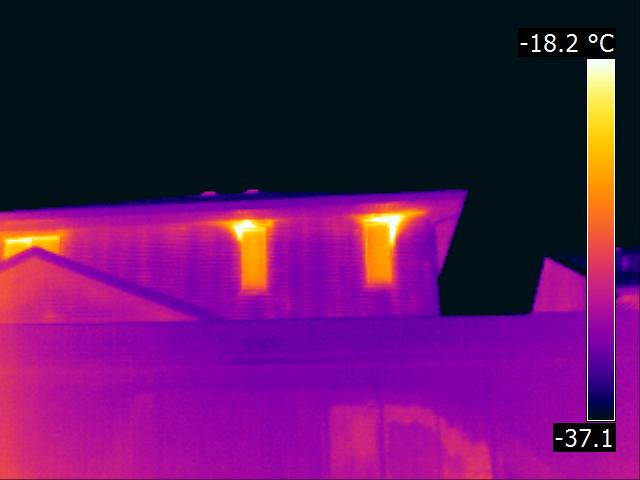Here are a few images of heat loss (exfiltration) at exterior envelope.
Kevin







Here are a few images of heat loss (exfiltration) at exterior envelope.
Kevin







Kevin
I realize that you have been doing this longer than myself, but I took some pictures that are similar and was wondering if there is a reflection from the window?
Your comments please
Thanks
Lawrence Olsen
If you are referring to the tree branches in the windows, yes ![]()
Kevin
No I am refering to the lighter area above the windows.
Lawrence
You mean the hot air exfiltration leaking from the top of the windows. That’s no reflection, trust me. It’s hot air leaking from the windows ![]() These are older double hung windows. Most of the window locks at the meeting rails were worn or loose causing the upper sash to drop. I confirmed the gaps at the top of each of these windows. Very leaky!!
These are older double hung windows. Most of the window locks at the meeting rails were worn or loose causing the upper sash to drop. I confirmed the gaps at the top of each of these windows. Very leaky!!
Kevin
Thanks for that. I stand corrected.
If I could figure out how to get a picture on here I would post the one that I have.
Lawrence
When you are posting a reply to a thread, just hit the “Manage Attachments” button under additional options. A pop-up window will appear where you can brouse your computer to find the file you want to upload. Once the file uploads, close the attachment window and post the thread.
Love to see your images ![]()
Kevin
Here they are let me know what you think.


Thanks
Lawrence
Awesome! I really like the second one. Good example of air exfiltration.
What camera do you have?
Kevin
Hello Kevin & Lawrence,
Nice pics
What time of the day or night are taking these readings.
Scans come out nice when you have a good Delta T. (70 degrees?)
It’s below zero F there. The hot spots are -.76F
Night time…few hours after sunset.
Kevin
For an effective exterior building envelope scan you have to have a minimum of 18 deg F temperature differential. Not only for the time of scan, but for several hours before the scan.
I’m not sure how Lawrence tuned his camera, but my Delta-T was around 35 deg F.
Kevin
Thanks guys
Mine were taken about 5 hours after sunset with a outside temp of -25C. (sorry for the metric). These pics were taken with a FLIR EX320 with a wide angle lens.
The delta T that you are talking about is that outside temp from mid day to night or are you talking from inside to outside?
Lawrence
I would not say that you “have to have” but the more the better!
Down here in the South it can be very difficult to get temperature differential.
This does not mean the camera will not work for you.
The quality of the scan will substantially degrade and air movement, sunlight, HVAC etc. will substantially affect the capacity to detect thermal anomalies. The camera is capable of temperature differentials below 1°C. That’s all you need to get an anomaly to show up.
I would highly recommend that the 18°F temperature differential not be disregarded if it can be achieved.
I also recommend that your report documents if testing was conducted outside of the 18°F temperature differential recommendation. As this is an industry standard, any deviation from it warrants explanation.
Inside/outside.
Thanks for clarifying David.
In Canada we were taught delta T of 10C to 15C. Conversion tells me that 18F is about 8C. Close enough! I do not know the Delta T because I was just playing with the camera that night and shooting houses for the fun of it. Normally houses inside temp is 20C so I am guessing that I would have a Delta T of 40C or 104F. That should be enough ;).
Thanks
Lawrence Olsen
It just performed this test at my office on a known “minor” thermal anomaly under these conditions:
Indoor/outdoor air temperature differential: 21.6°C/21.2°C = .4° temperature differential C.
Apparent wall temperature scale in thermal scan: 21.6°C/23 .5°C = 1.9° temperature differential C.
Outdoor air temperature 21.6°C. Windspeed 14 mph with 25 mph gusts. Dewpoint temperature 17°C. Relative humidity 76%.
The indoor/outdoor air temperature was taken with a calibrated thermalcouple.
The apparent wall temperature scale was determined by the BCAM and quick report software.
The palate was “mid-green” with the scale set at 23.8°C - 21.5°C.
Under no circumstances would I consider conducting a thermal scan under these conditions, however this is an example of the BCAM’s capabilities under actual conditions.
David
That is ugly. Sure glad I did not go with the BCAM.
Lawrence